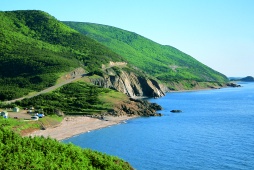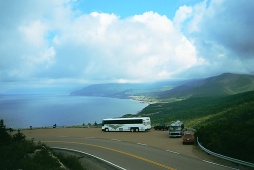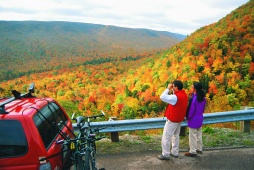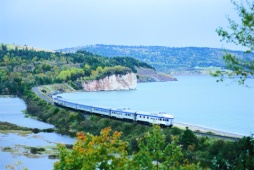
|
|||||||||||||

|
|||||||||||||
Cape Breton Island- Ceilidh, Cabot, Fleur-de-lis, Marconi Trails, Bras d'Or Lakes & Cape Breton -Nova Scotia, Kanada
|

|
||||||||||||
Cape Breton Island in Figures Cape Breton Island has a size of 10,311 sq km and has a length of approx. 175 km and a maximum width of 135 km. The Cape Breton Highlands feature with 554 m ( 1,800 ft.) the highest elevation of Atlantic Canada. Cape Breton Island is bordered by the Atlantic Ocean, Gulf of Saint Lawrence, and the Strait of Canso. Cape Breton Island is home to 166,116 people, about 70 per cent of which live in Cape Breton County. Cape Breton is divided by the narrow Strait of Canso. A 2 km bridge provides service to the mainland. The Canso Causeway, in fact the world's deepest causeway was completed in 1955. Ceilidh Trail The Ceilidh Trail follows the western shore from the Canso Causeway to the Cabot Trail for 107 km (67 mi) and offers breathtaking vistas of rugged coastline, bays and inlets. Strong Scottish heritage is all present at this scenic drive. Ceilidh (pronounced kay-lee) is a Gaelic word and stands for party or gathering. You might even hear bagpipes and fiddles. Tour a distillery, explore fascinating local museums, or take a leisurely drive (approx. 53 km or 33 mi) around lovely Lake Ainslie. Beautiful Lake Ainslie is the largest freshwater lake in Nova Scotia and is nestled between the green rolling hills of the Mabou Highlands. The route around the lake is popular with joggers and cyclists. Points of Interest Port Hastings Museum and Archives (WA *) This 100-year-old house, located at 9 Church St., offers an insight of local history including displays on the construction of the world's deepest man-made causeway. For more information call (902)-625-1295 Celtic Music Interpretative Centre (WA *) This museum, located in Judique, showcases a collection of traditional Cape Breton culture. On display are the largest fiddle in the world, a photo gallery, family tartans and a vintage interview collection. For more information call (902)-787-2708 Glenora Distillery North America's only distiller of single malt whiskey is located 9 km (5.5 mi) north of Mabou on Route 19. Visitors can tour the distillery and the Single Malt Whiskey Economuseum. On site you will find an inn, pub, dining room and gift shop. For more information call (902)-258-2662 or toll-free at 1-800-839-0491 MacDonald House Museum (WA *) This museum is located on Lake Ainslie, at 2458 Hwy 395 and features a 150-year old farmhouse in gothic-style. Discover the settler's farm life in the late 1800s in form of crafts, housing loom and a spinning wheel, farm machinery and tools, as well as a restored one-room schoolhouse (approx. 1920). In summer you can witness square dance performances and concerts. For more information call (902)-258-3317 Events Don't miss one of Cape Breton's most popular Scottish music festivals! The open-air Broad Cove Concert is held the last Sunday in July. Cabot Trail
The trail is home to the world famous Cape Breton Highlands National Park, one of Canada's most exceptional wilderness areas. The Cabot Trail is a four season playground, with endless groomed trails for cross-country skiing, and Ski Cape Smokey's 300-m vertical drop, Atlantic Canada's unique downhill experience. Hunter's Mountain is one of Nova Scotia's most popular winter playgrounds. Golfers will find world-class championship courses, surrounded by the magnificent beauty of Cape Breton Highlands National Park or scenic views of the Bras d'Or Lakes. Acadian history comes to life in the Acadian Museum in Cheticamp. Cheticamp is a busy fishing village with Acadian French still being spoken. Cheticamp is a centre for rug hooking. Works can be found in local shops, galleries and museums. An unusual tourist attraction can be found in the villages of Belle Côte, Terre Noire and Cap Le Moine, where the Scarecrow Theatre displays over 100 scarecrows dressed and masked to represent politicians, actors and other famous people. French food, music and dance are worth sampling, while visiting this French district. The village of Pleasant Bay is home to the fascinating Pleasant Bay Whale Interpretive Centre. Boat tours can be booked for whale watching at several places within the village. Lone Shieling Trail, towards Ingonish, (approx. 1km or 0.5 mi) leads through a magnificent virgin forest of 300-year-old sugar maples. Bay St. Lawrence is an attractive seaside village, that is popular with deep sea fishermen and whale watchers. Accessible by unpaved road only, you will get to Meat Cove, a small, remote community, that is noted for its rare orchids, some of which can be found nowhere else in Nova Scotia. The drive to this community offers some of the most stunning vistas.
North River Provincial Park is popular with anglers who come and enjoy fishing in the pools of the North River. A trail (18 km or 11 mi return) leads through the deeply forested river valley to North River Falls, which, at 30 m (100 ft), is the highest waterfall in Nova Scotia. The city of Baddeck is blessed with a beautiful setting on the shores of the Bras d'Or Lakes and boasts a wide variety of recreational activities including tennis, walking and hiking to guided sea kayaking and cycling tours. Baddeck was the beloved home of Alexander Graham Bell, the famous inventor and teacher. The Alexander Graham Bell National Historic Site, located in the eastern part of Baddeck, showcases one of the world's largest collection of artefacts about Bell's life. Points of Interest Alexander Graham Bell National Historic Site (WA *) Located in Baddeck at Chebucto St (Hwy. 205), this historic site displays the life of Alexander Graham Bell with original artefacts, personal mementos and photographs. For more information call (902)-295-2069 Margaree Salmon Museum (WA *) Located in North East Margaree at 60 East Big Intervale Rd., this museum shows an excellent collection of fishing tackle, photos and memorabilia of famous anglers. The museum is located in a former schoolhouse. For more information call (902)-248-2848 Scarecrow Theatre Located in Cap Le Moine this outdoor attraction displays more than 100 scarecrows in various dress and poses. For more information call (902)-235-2108 Acadian Museum (WA *) Located in Cheticamp at 744 Main St. this museum displays relics of the Acadian people of this area. Enjoy demonstrations of wool carding, spinning, weaving and rug hooking. For more information call (902)-224-2170 Whale Interpretive Centre (WA *) Located in Pleasant Bay, this unique centre offers an insight of the whale's world with life-size models, exhibits and interactive media. For more information call (902)-224-1411 Giant MacAskill Museum Located in Englishtown 2.5 km (1.5 mi) off Hwy 105 on Route 312, this museum displays artefacts of the life of Angus MacAskill, the Cape Breton giant who stood 7 ft. 9 in. tall. See his chair, clothing, bed, boot and walking sticks as well as items of interest from the early 1800s. For more information call (902)-929-2925 Cape Breton Highlands National Park (WA *) The headlands and cliffs of Cape Breton Highlands tower over the rich, natural heritage that is all around. Home to the famous Cabot Trail, the land is blessed with spectacular scenery, abundant wildlife and a human history that stretches back to the last Ice Age. The park offers many accessible treasures and experiences remarkable in their diversity, beauty, and wonder. For more information call (902)- 224-2306 Bras d'Or Lakes Scenic Drive
The town of Whycocomagh, named after the Mi'kmaq word meaning "head of the waters", is one of the regions busiest communities. Native handicrafts can be found in several roadside shops within the Waycobah Reserve. Nearby Whycocomagh Provincial Park features a picnic area and campground with exceptional views of St. Patrick's Channel. Marble Mountain, a small picturesque village offers great views of the Bras d'Or Lakes and the many islands. A museum shows the fascinating history of the village and the nearby marble quarry. The village also features an unique marble-chip beach. St. Peter's, situated on a narrow strip of land separating the Atlantic Ocean and the Bras d'Or Lakes, features the St. Peter's Canal, that connects both bodies of water. St. Peter's Canal has been completed in 1869 and is a National Historic Site. The canal also boasts the only functioning lock system in Nova Scotia. View interpretive exhibits, enjoy a picnic lunch, or experience the canal by pleasure craft. Just past St. Peter's is Chapel Island First Nations Reserve, one of the oldest Mi'kmaq settlements in the province. Traditional drumming, dancing and story-telling are featured daily in a re-enactment of a 16th-cenury encampment. Scottish history comes alive in the Highland Village in Iona. This living museum recreates the 200-year history of Scottish settlement in Cape Breton. You will see ten restored historic buildings within this 43-acre village. Besides the historical aspect the village offers some panoramic views of the Bras d'Or Lakes and surrounding countryside.
Orangedale Railway Station Museum Located off Hwy 105, Exit 4 this 19-th century railway station houses railway artefacts, stationmaster quarters, model railway and original furniture. For more information call (902)- 756-3384 Nova Scotia Highland Village Museum Located on 4119 Route 223 - 19 km (12 mi) east of Hwy 105, Exit 6 this museum is devoted to the early Scottish settlers. Ten historic buildings are on display. For more information call (902)- 725-2272 Fleur-de-lis Trail, Marconi Trail and Metro Cape Breton Fleur-de-lis Trail The Fleur-de-lis Trail leads you from the Canso Causeway to the Fortress Louisbourg and has a total length of 263 km. You will pass one of Nova Scotia's most unspoiled and beautiful stretches of Atlantic coastline. Port Hawkesbury, situated minutes from the Causeway offers an attractive waterfront. The Granville Green series of free outdoor concerts, each Sunday evening in July and August, features some of Atlantic Canada's best performing artists. The town of Arichat is one of the oldest communities in Nova Scotia and has once been a booming Atlantic seaport. Our Lady of the Assumption Cathedral, built in 1837, is a typical large wooden church built by Acadians. The LeNoir Forge Museum is a restored 1793 shipbuilder's blacksmith shop. Regular demonstrations of the blacksmith's art are offered. Petit-de-Grat is the oldest fishing village in the area. Little Anse, on Petit-de-Grat Island is a photographer's delight with typical fishermen's houses and coves. L'Ardoise, a small Acadian village celebrates the Festival Acadien de L'Ardoise in July. Point Michaud offers one of the region's most spectacular sand beaches.
The Marconi Trail The Marconi Trail leads you from Louisbourg to Glace Bay, linking the three historic Marconi transatlantic wireless station sites. The 60 km (37 mi) trail is named after the Italian inventor Guglielmo Marconi, who spent several years in Cape Breton while building three transatlantic wireless stations. The Main-à-Dieu Fishermen's Museum is located in the largest fishing village on this coast and offers a ship replica and displays the local history of fishing. Glace Bay has a history in coal mining, which is displayed at the Miner's Museum, one of the region's most popular attractions. Visitors can take a guided tour into the Ocean Deeps Colliery, a real coal mine that lies below the museum. The Marconi National Historic Site, situated in Glace Bay, marks the place from which Guglielmo Marconi sent the first wireless transatlantic signal in 1902. Metropolitan Cape Breton Cape Breton Regional Municipality is Nova Scotia's second-largest city and includes the communities of Sydney, Reserve Mines, Glace Bay, Dominion, New Waterford, North Sydney, Sydney Mines, Louisbourg and Cape Breton County. The Colliery Route links sites of interest in the coal-mining history of north-eastern Cape Breton. The tour begins at Glace Bay and follows Route 28 to Dominion and then through New Waterford and Victoria to Sydney. Maps are available at the Miner's Museum and at visitor information centres. Sidney's oldest historic houses can be found in Charlotte Street. Cossit House was built in 1787 and is the oldest house Sydney's. Today it is furnished circa 1818 and can be toured by tourists. Nearby, Jost House has about the same age. However it displays several different architectural styles representing its 200-year history. Cape Breton Island's oldest Catholic church is St. Patrick's Church, located on the Esplanade. It was built in 1828 and now serves as a museum. Points of Interest Two Rivers Wildlife Park (WA *) Located in Marion Bridge, off Route 327, west to Two Rivers, this 500-acre park showcases many native Nova Scotian animals in a natural setting. For more information call (902)-727-2483 Fortress of Louisbourg National Historic Site (WA *) Excellent re-creation of a 18th-century town with costumed animators. Guided walking tours available. For more information call (902)-733-2280 Marconi National Historic Site (WA *) Located in Glace Bay, Timmerman St this National Historic Site marks the place, where Guglielmo Marconi initiated the age of global communication almost a century ago. For more information call (902)-295-2069 Miner's Museum (WA *) Located in Glace Bay at 42 Birkley St., this museum displays the local coal-mining history. A guided tour of the Ocean Deeps Colliery is available and is the highlight of this museum. For more information call (902)-849-4522 The Bras d'Or (WA *) Discover the province aboard this first-class train from Sydney to Halifax. Enjoy panoramic views of Nova Scotia from the glassed-in dome of the Skyline Car on this 10-hr tour. For more information call toll-free at 1-800-561-3952 ----------------------------------------------- * WA - Wheelchair accessible |
|||||||||||||
Back
|
|||||||||||||






